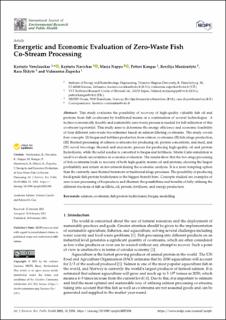| dc.contributor.author | Venslauskas, Kęstutis | |
| dc.contributor.author | Navickas, Kęstutis | |
| dc.contributor.author | Nappa, Marja | |
| dc.contributor.author | Kangas, Petteri | |
| dc.contributor.author | Mozuraityte, Revilija | |
| dc.contributor.author | Slizyte, Rasa | |
| dc.contributor.author | Župerka, Vidmantas | |
| dc.date.accessioned | 2022-09-19T10:14:34Z | |
| dc.date.available | 2022-09-19T10:14:34Z | |
| dc.date.created | 2021-08-04T11:58:35Z | |
| dc.date.issued | 2021 | |
| dc.identifier.citation | International Journal of Environmental Research and Public Health (IJERPH). 2021, 18 (5), 1-16. | en_US |
| dc.identifier.issn | 1661-7827 | |
| dc.identifier.uri | https://hdl.handle.net/11250/3018835 | |
| dc.description.abstract | This study evaluates the possibility of recovery of high-quality valuable fish oil and proteins from fish co-streams by traditional means or a combination of several technologies. A techno-economically feasible and sustainable zero-waste process is needed for full utilisation of this co-stream’s potential. This study aims to determine the energy efficiency and economic feasibility of four different zero-waste bio-refineries based on salmon filleting co-streams. The study covers four concepts: (I) biogas and fertiliser production from salmon co-streams, (II) fish silage production, (III) thermal processing of salmon co-streams for producing oil, protein concentrate, and meal, and (IV) novel two-stage thermal and enzymatic process for producing high-quality oil and protein hydrolysate, while the solid residue is converted to biogas and fertilisers. Monte Carlo simulation is used to evaluate uncertainties in economic evaluation. The results show that the two-stage processing of fish co-streams leads to recovery of both high-quality marine oil and proteins, showing the largest profitability and return on investment during the economic analysis. It is a more tempting option than the currently used thermal treatment or traditional silage processes. The possibility of producing food-grade fish protein hydrolysate is the biggest benefit here. Concepts studied are examples of zero-waste processing of bioproducts and illustrate the possibilities and benefits of fully utilising the different fractions of fish as fillets, oil, protein, fertilisers, and energy production. | en_US |
| dc.language.iso | eng | en_US |
| dc.publisher | MDPI | en_US |
| dc.rights | Navngivelse 4.0 Internasjonal | * |
| dc.rights.uri | http://creativecommons.org/licenses/by/4.0/deed.no | * |
| dc.subject | modelling | en_US |
| dc.subject | biogas | en_US |
| dc.subject | fish protein hydrolysate | en_US |
| dc.subject | co-stream | en_US |
| dc.subject | salmon | en_US |
| dc.title | Energetic and Economic Evaluation of Zero-Waste Fish Co-Stream Processing | en_US |
| dc.type | Peer reviewed | en_US |
| dc.type | Journal article | en_US |
| dc.description.version | publishedVersion | en_US |
| dc.rights.holder | Copyright: © 2021 by the authors. Licensee MDPI, Basel, Switzerland. This article is an open access article distributed under the terms and conditions of the Creative Commons Attribution (CC BY) license (https:// creativecommons.org/licenses/by/ 4.0/). | en_US |
| dc.source.pagenumber | 1-16 | en_US |
| dc.source.volume | 18 | en_US |
| dc.source.journal | International Journal of Environmental Research and Public Health (IJERPH) | en_US |
| dc.source.issue | 5 | en_US |
| dc.identifier.doi | 10.3390/ijerph18052358 | |
| dc.identifier.cristin | 1923822 | |
| cristin.ispublished | true | |
| cristin.fulltext | original | |
| cristin.qualitycode | 1 | |

